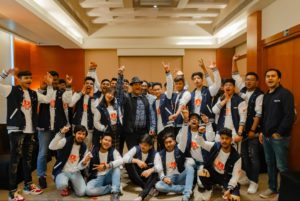First, he had to reassure his parents. An audit associate with one of the Big Four accounting firms in Singapore, Jason Lim decided to take a leap of faith away from a cozy career in finance, into an uncertain job future. It was in January 2017, when he joined Garena. Only one year later, Lim was a producer of what became the company’s blockbuster game, Free Fire.
“It was a really difficult decision to make at that point in time, having to weigh the trade-off between working in a well-established industry and pursue something that aligns with my personal interests,” he told KrASIA in a recent interview.
Lim could not resist the opportunity to follow his personal passion. “When presented with the chance at Garena, I simply could not turn it down. It was a rare opportunity where my interests and work could genuinely merge, when most of my peers were treating their jobs solely as an income-generating activity,” he said.
Being an avid gamer, the perspective was attractive. The sector was still in its nascent stages, and it was challenging to find a job that could offer a stable income. “I knew that joining them would naturally translate to more opportunities,” he said.
Armed with a Bachelor of Business, Lim has knowledge in strategy, marketing, and business operations—all crucial parts of his role. Additionally, his Bachelor of Accountancy made it easier to work on the corporate side of things, such as forecasting, reviewing tax laws, and evaluating counterparty credit risks.
Growing the game
“I often compare my role as a game producer to that of running a business, where the goal is to maximize the player’s base and revenue,” he said. “In the course of achieving that, game producers are facing a myriad of opportunities and challenges, such as the geographical market, the state of the industry, local regulations, and plenty other factors.”
There is no step-by-step guide or playbook. “We do everything it takes to grow the game as a business through our operations, which includes marketing, revenue optimization, e-sports, and product development. So I could be planning an influencer marketing campaign, reviewing the sales price of a new skin, going through tournament replays to spot hacking activities, and reviewing a new regulation—all on the same day,” he added.

The gaming industry is relatively new, so there’s still plenty of room for experimentation and breaking new frontiers. “That’s one of my favorite parts of the job—getting to work on exciting global collaborations such as Free Fire and Money Heist. I’m a big fan of the Netflix series,” Lim said. They joined forces with Ragnarok Online, a “generational favorite” among gamers, according to him. “We also partnered with Hrithik Roshan, one of India’s biggest celebrities, to bring him into the game as Free Fire’s first playable Indian character.”
Lim says that people always ask whether he plays games every day. “The answer is yes—I play games every day, for both work and for entertainment,” he said. “One of the perks in the gaming industry is that I get to play while on the clock. But when I do, it is often with a specific objective rather than enjoying in a leisurely sense.”
Knowing how to code is a useful skill too, but definitely not a must for a producer. “It can be learned on the job,” he points out. More important is it to be adaptable, an essential quality in a fast-moving sector. People who are gamers themselves and who understand the psyche of a gamer are much more likely to produce something that is fun and engaging.

Garena has put a focus on localization. The company is currently trying to learn more about the Indian community and has been engaging experts to better understand how it can appeal to that demography and expand its user base. “It includes our player community, our streamers, and content creators, as well as various endemic and non-endemic brands and celebrities,” he said.
“We launched a Diwali-themed campaign that was specially developed for our players in India, for them to celebrate a #FreeFireDiwali while staying safe at home,” he explains. The campaign offered a variety of localized in-game events, and also included its first Indian costume, a Diwali-themed music video by popular singer-songwriter Ritviz, called Jeet, as well as tournaments that brought together the community’s favorite Free Fire influencers and e-sports teams.
Free Fire is an immersive battle royale game that has been created specifically with mobile users in mind. Developed and published globally by Garena, it was the most downloaded mobile game worldwide in 2019 and 2020, according to App Annie. In Q2 2020, it achieved a new record high of over 100 million daily active users at the peak.
Read this: Burmese youths turn virtual fun into rewarding e-sports careers
“Players are attracted to Free Fire because we have built and continue to build strong communities wherever our gamers are, through grassroots events, by engaging local influencers,” Lim said. Before the lockdowns in early 2020, Garena organized a YouTube influencer party in Goa, India—the first of its kind in this market—where it brought together over 20 of the nation’s top Free Fire streamers for two days of bonding.
Lim, who is in charge of both India and Malaysia, explains that the countries are at different stages in terms of maturity. Malaysia is one of the biggest markets in Southeast Asia, with its 20.1 million gamers who spent USD 673 million in 2019, according to Newzoo. And it continues to grow rapidly primarily due to a high proportion of smartphone ownership, with more than three in four residents owning a device in 2018.
In India on the other hand, only around one in four has one. “Although India’s smartphone ownership levels are rapidly rising, the low penetration rate means that we’re barely scratching the surface of its potential,” Lim said. “With limited insight into user preferences, consumption patterns, and gaming behavior, we know that there is much to learn.”
(The article has been updated with more recent App Annie data.)
This article is part of “Profiles in Tech,” a series by KrASIA that highlights the achievements of people who are the driving force behind South and Southeast Asia’s tech startups.

